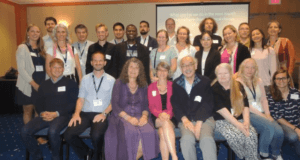September 2017: A BIG Day for a Big Idea
In this edition:
- Home is where the harm can be – And the BIG IDEA can change that!
- Highlights from DIOXIN 2017
- Horrors of the Deep: Our Toxic Legacy Still Haunts Us

Yesterday was indeed a very BIG day for our “Big Idea” petition! In a landmark decision,
The US Consumer Product Safety Commission holds a hearing on organohalogen flame retardants
the U.S. Consumer Product Safety Commission (CPSC) granted our joint petition to protect children, firefighters, and consumers from the entire harmful chemical class of organohalogen flame retardants in children’s products, furniture, mattresses, and electronics cases.
In collaboration with Earthjustice and a coalition of NGO colleagues we submitted the petition in 2015. Many years of hard work paid off yesterday when, to our amazement, the CPSC commissioners voted to enact the petition. This provides a ground-breaking example of how government can use the chemical class concept for improved regulations to protect people from toxics. This ruling sets a precedent of considering entire classes of chemicals with similar properties and similar hazards, preventing the common practice of considering one chemical at a time which leads to the “regrettable substitution” problem.
While the new rule is being enacted, the CPSC will publish a Guidance Document in the Federal Register advising manufacturers of children’s products, furniture, mattresses and electronics cases to decrease the unnecessary use of organohalogen flame retardants in their products. This should go a long way towards moving the market towards healthier products – a boon for our health and environment.
Here at the Institute, we have been working with outstanding scientists and advocates for a decade on the scientific basis for this petition. It all began in 2007 with AB706, a visionary California bill in collaboration with Mark Leno, Bart Broome, Russell Long, Andrew McGuire, and Mary Brune to ban organohalogen flame retardants in furniture. AB706 did not succeed, but the idea was born.
In 2011, the New York Community Trust began providing invaluable support for the Big Idea. Over the next years, our Institute staff collaborated with Eve Gartner from Earthjustice to assemble the petition. A special thanks to David Eastmond and Virunya Bhat of UC Riverside for providing the toxicological basis for the petition and to Terry Collins, Miriam Diamond, David Epel, Rolf Halden, Kim Harley, Julie Herbstman, Susan Kasper, Don Lucas, Sharyle Patton, Ruthann Rudel, Ted Schettler, and Roland Weber for providing detailed scientific statements.
Here’s a fun message from Rolf Haden, one of the scientists: “Congratulations on accomplishing what looked seemed impossible to achieve just yesterday! This landmark ruling …may be the beginning of the end of regrettable substitutions, finally putting public health first when deciding on the type of chemistry around and within us.”
Kind regards,
Arlene and the GSP team
Home is where the harm can be – And the BIG IDEA can change that!

It’s a sad fact: common household items can contain
some of the most toxic chemicals invuse today. Consider organohalogen flame retardant chemicals found in the bodies of over 97% of US residents. Despite being associated with cancer, infertility, obesity, reduced IQ in children, hormone disruption, and lowered immunity, they continue to be used in consumer products. A very unfortunate part of their use is that young children have three to five times higher levels or even more of these toxic flame retardants in their bodies compared to their parents-exactly when their developing brains and reproductive organs are the most vulnerable. And the chemicals don’t even work as promised to reduce fires in furniture, baby products, mattresses and electronics cases!
In a memorable discussion following yesterday’s CPSC vote on our petition to protect Americans from this class of harmful chemicals, Commissioner Elliot Kaye statedthat we should always choose to protect children over protecting chemicals.
Highlights from DIOXIN 2017

The 37th International Symposium on Halogenated Persistent Organic Pollutants in Vancouver, Canada, featured more than four days of presentations by leading researchers. Presentation abstracts are expected to be posted online.
Scientists from more than a dozen countries joined our one day long science and policy workshop to share strategies for using the class concept to reduce toxins. Below are some highlights:
- Miriam Diamond from the University of Toronto discussed occupational exposures in a Canadian e-waste recycling facility, and Stuart Harrad from the University of Birmingham presented a study of PBDE leaching from recycled plastic cooking utensils. These presentations reminded us that when it comes to persistent pollutants, there is no “away”.
- Roxana Suhring, a UK scientist presented work on emissions of firefighting foam from offshore oil rigs, which is a major overlooked source of PFOS to the oceans.
- Researchers in the Netherlands and China reported on levels of PFOA replacement GenX and other newly discovered highly fluorinated chemicals in surface water, drinking water, and even frogs.
- Dutch researchers reported that simulated weathering of outdoor garments increased the measurable levels of highly fluorinated chemicals in the garments.
Horrors of the Deep: Our Toxic Legacy Still Haunts Us

This summer, the UK lost one of its last killer whales.
Lulu’s body contained high levels of PCBs – an industrial chemical banned almost two decades before Lulu was born. The highest PCB levels ever measured in any marine mammal were found in bottlenose dolphins off the coast of Brunswick, Georgia. Just upstream, coastal communities are eating the same seafood as the dolphins, building up PCBs that pass from mother to child. How did our oceans become so contaminated with a chemical banned forty years ago?
Read more in our blog.
Receive Updates By Email
Subscribe to our monthly newsletter and get these updates delivered right to your inbox!